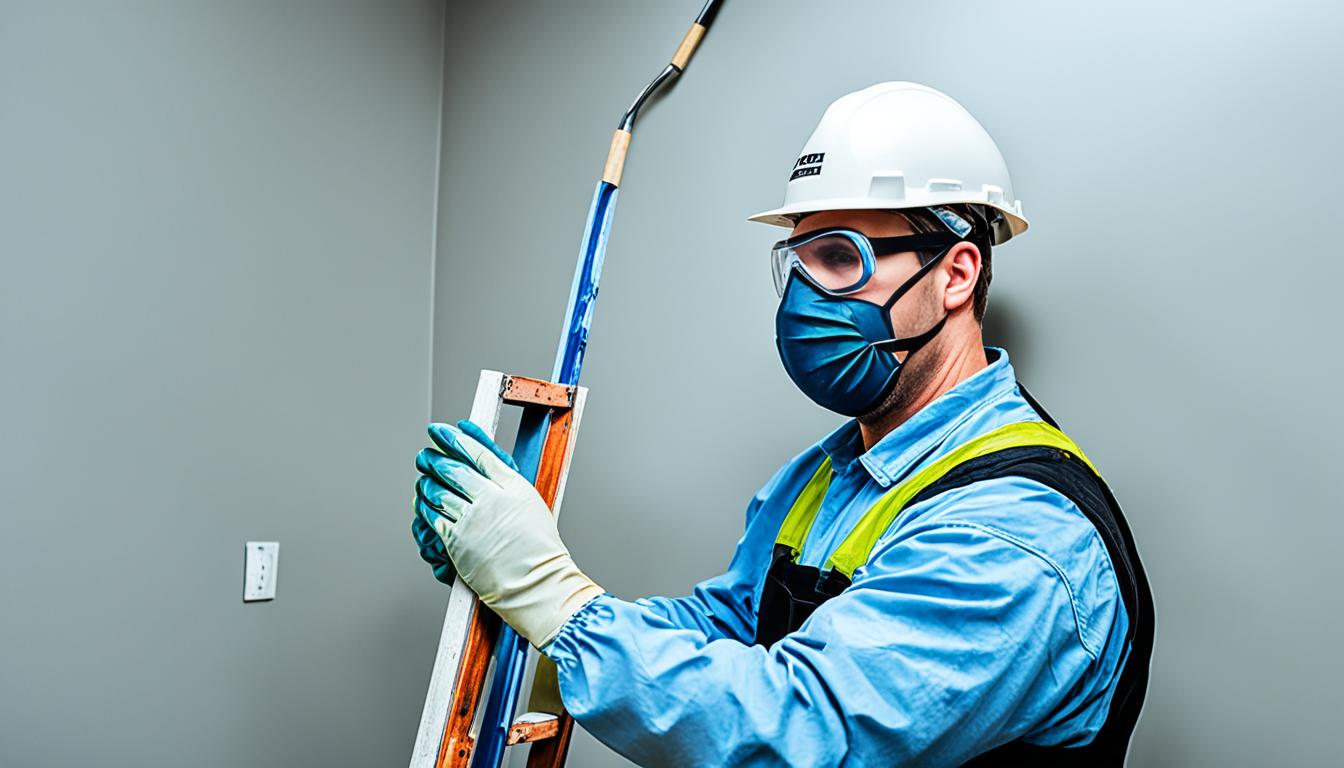When I start to paint my home, I care a lot about safety. It’s not just picking colors or the best brush. It means making sure I’m safe and so is everyone else. I open windows and doors to get air moving. Sometimes, I also use fans. This is very important when using paints that smell strong. I wear a respirator or mask to protect myself from feeling dizzy, getting headaches, or feeling sick from the paint smells.
I wear gloves, goggles, and long-sleeve shirts to keep my skin and eyes safe. Being careful about cleaning up and waiting for the paint to dry keeps my home safe. It’s important for kids and pets too. By focusing on safety and the joy of new paint, I make my home a happy place without accidents.
Key Takeaways
- Open windows and doors to optimize ventilation during your painting project.
- Utilize a respirator or painter’s mask to protect against harmful fumes.
- Don’t skimp on PPE like gloves, goggles, and long-sleeve shirts for extra skin and eye protection.
- Maintain a strict clean-up routine and allow proper paint drying time for a safe home environment.
- Remember, safety measures enhance the enjoyment and satisfaction of your interior painting endeavor.
The Importance of Ventilation During Interior Painting
When painting indoors, making sure the room has good air flow is key. This matters for my health and comfort. The National Capital Poison Center says paint smell can cause issues like dizziness and headaches.
To keep air clean, I always open all windows and doors. Using fans also keeps the air moving. This helps get rid of harmful air. Here’s how different ways to get fresh air help keep painting safe.
| Method | Description | Benefits |
|---|---|---|
| Open Windows/Doors | Increases natural airflow | Disperses fumes quickly and effectively |
| Ceiling/Wall Fans | Encourages active air movement | Helps maintain a consistent air exchange rate |
| Portable Fans | Aimed at specific areas for targeted ventilation | Focuses on removing stagnant air from corners |
Also, choosing paints with low or no VOCs is crucial. These paints have fewer bad chemicals. This makes them safer.
Wearing a mask or respirator is another smart move. It helps me not breathe in bad vapors. This simple tool makes me feel safer.
By following these steps, painting a room becomes a safe, fun task. It lets me change a space without risking my health. These tips help make sure painting at home is safe and healthy.
Personal Protective Equipment (PPE) You Need for Painting Jobs
When starting a painting job, wearing the right protective gear for painting is very important. This gear helps avoid harmful chemicals and keeps you safe. We will look at important PPE for painting projects.
Protect your eyes and skin first. Always wear goggles and chemical-resistant gloves. These protect you from paint splashes and chemicals. Wear long-sleeve shirts too. They give an extra layer of skin protection.
- Goggles to protect eyes from chemical splashes
- Chemical-resistant gloves to minimize direct skin contact
- Long-sleeve shirts to cover skin areas
If you’re sanding or near dust, wear a quality dust mask or respirator. These help keep your breathing air clean. Also, wear an old hat. It protects your head and hair from chemicals.
Always wear these safety items when painting. They reduce the risks of chemical exposure. Safety gear is needed for a safe and successful painting job.
Ladder Safety Tips for a Hazard-Free Painting Experience
Proper ladder usage is key for safe and efficient painting. Many people overlook safety with ladders. This causes accidents. By following some important rules, I keep my painting safe and smooth.
First, I make sure my ladder is stable before anything else. A shaky ladder is dangerous. It must sit on a flat surface. Also, I follow advice from the Occupational Safety and Health Administration. It’s about keeping three points of contact with the ladder. This means two hands and a foot, or two feet and a hand, must always touch the ladder. This helps prevent falls and keep balance. It’s very helpful, especially when I need to reach high spots.
Avoiding overreaching is also crucial. Reaching too far can cause accidents. So, I move the ladder instead of stretching too far. It takes more time but is much safer. Overreaching can make you lose balance or tip the ladder over. I’ve learned it’s not worth the risk. Staying safe helps avoid accidents while painting.
| Ladder Safety Checklist | Do’s | Don’ts |
|---|---|---|
| Setup | Ensure surface is level and stable | Set up on uneven or soft ground |
| Contact Points | Maintain three points of contact | Overreach or lean away from the ladder |
| Positioning | Move ladder as needed instead of reaching | Use for unintended purposes |
Following ladder safety guidelines keeps me and the project safe. It means more than just doing the job right. A bit more time in setting up saves time and keeps you away from injuries or problems later. Safe painting is not just about the art. It’s also about how you safely position yourself. Stay safe and enjoy painting!
Post-Painting: Best Practices for Cleanup and Storage
When I finish painting, I know there’s more to do. Following paint cleanup procedures and safe storage solutions are key. They keep my place safe and tidy. Here’s what I do after painting:
- Thorough Cleanup: I quickly clean any spills with the right cleaners. For oil paint, I use mineral spirits but never pour it down the drain.
- Proper Disposal of Hazardous Waste: I don’t leave old paint and thinner lying around. I take them to a special disposal place for dangerous waste.
- Secure Storage: I make sure leftover paint is closed tight and stored in a safe, cool spot. This stops it from going bad or causing a fire.
- Rag Disposal: I’m careful with rags that have paint or solvent on them. Either I put them in a metal can or soak them, then throw them away safely to avoid fires.
Cleaning up and storing things right after painting keeps my home safe. It makes sure my space is both beautiful and secure. Following these steps is crucial for safety and cleanliness.
It doesn’t matter if you paint all the time or are just starting. Doing cleanup and storage the right way is very important. If we all follow these tips, our painted areas will stay beautiful and safe.
Ensuring Proper Drying Time Post Interior Painting
I know how exciting it is to finish a home makeover. We all want to see the dry, finished look fast. But, pros and DIY folks agree: being patient is key. Many think paint dries quickly, but that’s not true. It takes days for paint to dry properly. This time helps protect the paint and lets its color and texture fully develop.
While waiting, keeping the air moving is important. I make sure the painted room has good air flow. I open windows and run fans. This helps paint dry and keeps the air safe to breathe. It’s also important to keep kids and pets away from wet paint.
To keep your paint looking great, don’t touch the walls too soon. And try to use the room less. Good drying time and air flow help a lot. This way, our walls will look beautiful for a long time.
FAQ
What safety precautions should I take before starting an interior painting project?
Getting ready for a home makeover with paint? First, safety is key. Use safe painting methods like good room air flow. This lowers health risks. Also, wear the right safety gear and make sure your space is clean.
How do I ensure proper ventilation when painting indoors?
Keeping air moving is important to avoid dizziness or headaches. Open windows and doors for a good air flow. Fans help too. If using strong paints, a mask or respirator is a good idea.
What Personal Protective Equipment (PPE) do I need for an interior painting job?
Safety gear is a must to avoid chemicals. You should wear goggles, chemical-proof gloves, and long shirts. A mask or respirator is also good for dusty work.
Why is ladder safety important during painting projects, and how can I stay safe?
Falling off ladders is a big risk. Make sure your ladder is stable before climbing. Always have three points touching it and keep it level. Don’t stretch too far and move the ladder when needed to avoid falls.
What are the recommended cleanup and storage practices for paint supplies?
Done painting? Clean up paint carefully and toss rags safely. Store things in a cool, dry spot. Any leftover paint must go to a special drop-off spot.
How long should I wait for the paint to dry, and how do I ensure it’s done safely?
Paint drying takes more than a few hours. Sometimes, it needs days. Keep kids and pets away until it’s dry. Make sure the room is well-aired during this time to avoid safety issues.




